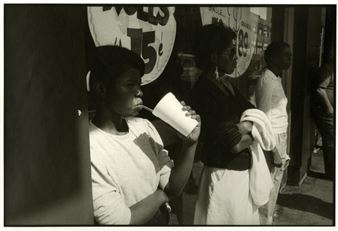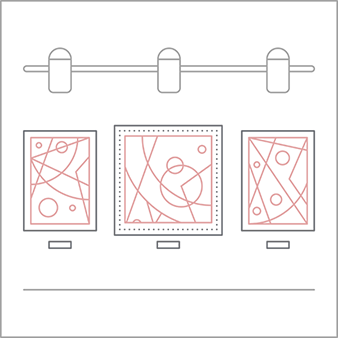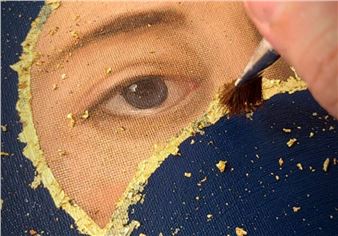Kermit Berg: Article 1: Human Dignity Shall Be Inviolable
SoNa Chicago Contemporary Art is proud to present the exhibition, Article 1: Human Dignity Shall Be Inviolable, featuring the artwork of Kermit Berg. The exhibit highlights both the beauty and the vulnerability of democracy.
In 2015, the American artist Kermit Berg was invited by the German government to photograph the buildings of the German Parliament in Berlin, known as the Bundestag. The building design includes architectural elements that highlight attributes of democracy such as transparency in government and governance by the people. Berg's photographs of the building capture these elements in his signature style.
The exhibition was to be shown in the newly constructed Library of Parliament building in Germany. The exhibition never happened due to lengthy construction delays, although the work was acquired by the Collection of the Federal Republic of Germany. Several years later, his body of work was slated for a show at the German Embassy in Moscow. However, criticism by the Russian government derailed these plans. An alternative location outside of Moscow was ultimately abandoned when Russia invaded Ukraine.
Today, democracy is palpably under threat around the world. For Berg, this means introspection, revisiting, and literally ripping up some of his earlier works. The result is his photographic series: “Torn” where he destroys and reassembles his prints with their fragments to represent the fragile nature of democracy.
Berg's “Bundestag” portfolio is not the first time he has examined democracy and political systems through his own very subtle lens. His 2013 series “Nuclear Family” documents the post-World War II relationship between a West Berlin family and an American family in rural Indiana. “Nuclear Family” led to a solo museum exhibition at Maerkisches Museum in Berlin, and has since been shown as part of the Kermit Berg retrospective at the Christel De Hahn Fine Arts Center in Indianapolis. Several of his works from the Nuclear Family portfolio are also in the exhibition at SoNa Chicago. As with “Article 1” his keen eye explores and reveals the heart of the theme, in this case, the nascent democracy in West Germany.
Article 1 is the first of nineteen proclamations of basic human rights comprising the beginning of the newly developed constitution of the Federal Republic of West Germany. It was ratified in 1949 and later adopted upon the reunification of Germany in 1990. This conscious intention to spell out basic rights at the very beginning of Germany’s new constitution paved the binding path forward for the emerging democracy. The framers of the basic rights document went on to say that to respect and protect human dignity is so important that it shall be the duty of all government authority to protect it, and that Article I cannot be changed or removed.

SoNa Chicago Contemporary Art is proud to present the exhibition, Article 1: Human Dignity Shall Be Inviolable, featuring the artwork of Kermit Berg. The exhibit highlights both the beauty and the vulnerability of democracy.
In 2015, the American artist Kermit Berg was invited by the German government to photograph the buildings of the German Parliament in Berlin, known as the Bundestag. The building design includes architectural elements that highlight attributes of democracy such as transparency in government and governance by the people. Berg's photographs of the building capture these elements in his signature style.
The exhibition was to be shown in the newly constructed Library of Parliament building in Germany. The exhibition never happened due to lengthy construction delays, although the work was acquired by the Collection of the Federal Republic of Germany. Several years later, his body of work was slated for a show at the German Embassy in Moscow. However, criticism by the Russian government derailed these plans. An alternative location outside of Moscow was ultimately abandoned when Russia invaded Ukraine.
Today, democracy is palpably under threat around the world. For Berg, this means introspection, revisiting, and literally ripping up some of his earlier works. The result is his photographic series: “Torn” where he destroys and reassembles his prints with their fragments to represent the fragile nature of democracy.
Berg's “Bundestag” portfolio is not the first time he has examined democracy and political systems through his own very subtle lens. His 2013 series “Nuclear Family” documents the post-World War II relationship between a West Berlin family and an American family in rural Indiana. “Nuclear Family” led to a solo museum exhibition at Maerkisches Museum in Berlin, and has since been shown as part of the Kermit Berg retrospective at the Christel De Hahn Fine Arts Center in Indianapolis. Several of his works from the Nuclear Family portfolio are also in the exhibition at SoNa Chicago. As with “Article 1” his keen eye explores and reveals the heart of the theme, in this case, the nascent democracy in West Germany.
Article 1 is the first of nineteen proclamations of basic human rights comprising the beginning of the newly developed constitution of the Federal Republic of West Germany. It was ratified in 1949 and later adopted upon the reunification of Germany in 1990. This conscious intention to spell out basic rights at the very beginning of Germany’s new constitution paved the binding path forward for the emerging democracy. The framers of the basic rights document went on to say that to respect and protect human dignity is so important that it shall be the duty of all government authority to protect it, and that Article I cannot be changed or removed.

 ARTISTS
ARTISTS











